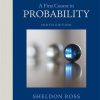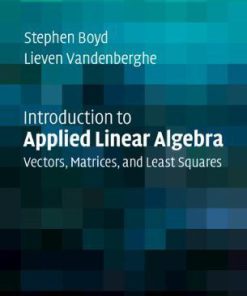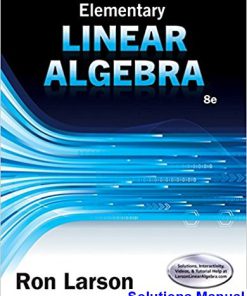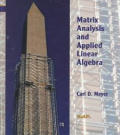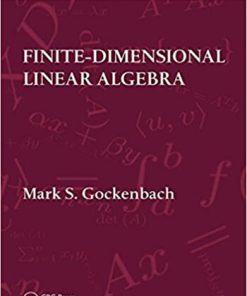Introduction To Linear Algebra 4th Edition Strang Solutions Manual
$55.00 Original price was: $55.00.$29.99Current price is: $29.99.
Introduction To Linear Algebra 4th Edition Strang Solutions Manual
This is completed downloadable of Introduction To Linear Algebra 4th Edition Strang Solutions Manual
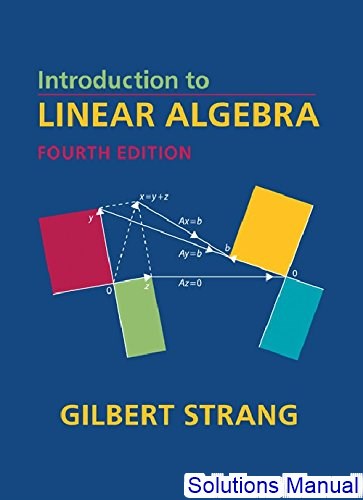
Product Details:
- ISBN-10 : 0980232716
- ISBN-13 : 978-0980232714
- Author: Gilbert Strang
This leading textbook for first courses in linear algebra comes from the hugely experienced MIT lecturer and author Gilbert Strang. The book’s tried and tested approach is direct, offering practical explanations and examples, while showing the beauty and variety of the subject. Unlike most other linear algebra textbooks, the approach is not a repetitive drill. Instead it inspires an understanding of real mathematics. The book moves gradually and naturally from numbers to vectors to the four fundamental subspaces. This new edition includes challenge problems at the end of each section. Preview five complete sections at math.mit.edu/linearalgebra. Readers can also view freely available online videos of Gilbert Strang’s 18.06 linear algebra course at MIT, via OpenCourseWare (ocw.mit.edu), that have been watched by over a million viewers.
Table of contents
- 1. Introduction to Vectors
- 1.1. Vectors and linear combinations
- 1.2. Lengths and dot products
- 1.3. Matrices
- 2. Solving Linear Equations
- 2.1. Vectors and linear equations
- 2.2. The idea of elimination
- 2.3. Elimination using matrices
- 2.4. Rules for matrix operations
- 2.5. Inverse matrices
- 2.6. Elimination = factorization: A = LU
- 2.7. Transposes and permutations
- 3. Vector Spaces and Subspaces
- 3.1. Spaces of vectors
- 3.2. The nullspace of A: solving Ax = 0
- 3.3. The rank and the row reduced form
- 3.4. The complete solution to Ax = b
- 3.5. Independence, basis and dimension
- 3.6. Dimensions of the four subspaces
- 4. Orthogonality
- 4.1. Orthogonality of the four subspaces
- 4.2. Projections
- 4.3. Least squares approximations
- 4.4. Orthogonal bases and Gram-Schmidt
- 5. Determinants
- 5.1. The properties of determinants
- 5.2. Permutations and cofactors
- 5.3. Cramer’s rule, inverses, and Volumes
- 6. Eigenvalues and Eigenvectors
- 6.1. Introduction to eigenvalues
- 6.2. Diagonalizing a matrix
- 6.3. Applications to differential equations
- 6.4. Symmetric matrices
- 6.5. Positive definite matrices
- 6.6. Similar matrices
- 6.7. Singular value decomposition (SVD)
- 7. Linear Transformations
- 7.1. The idea of a linear transformation
- 7.2. The matrix of a linear transformation
- 7.3. Diagonalization and the pseudoinverse
- 8. Applications
- 8.1. Matrices in engineering
- 8.2. Graphs and networks
- 8.3. Markov matrices, population, and economics
- 8.4. Linear programming
- 8.5. Fourier series: linear algebra for functions
- 8.6. Linear algebra for statistics and probability
- 8.7. Computer graphics
- 9. Numerical Linear Algebra
- 9.1. Gaussian elimination in practice
- 9.2. Norms and condition numbers
- 9.3. Iterative methods for linear algebra
- 10. Complex Vectors and Matrices
- 10.1. Complex numbers
- 10.2. Hermitian and unitary matrices
- 10.3. The fast Fourier transform
- Solutions to selected exercises
- Matrix factorizations
- Conceptual questions for review
- Glossary: a dictionary for linear algebra
- Index
- Teaching codes
People Also Search:
introduction to linear algebra 4th edition strang
introduction to linear algebra 4th edition strang download scribd
introduction to linear algebra 4th edition strang solution manual download pdf
You may also like…
Solution Manual
Solutions Manual to accompany Elementary and Intermediate Algebra 4th edition 9780321726346
Solution Manual
Solution Manual
Elementary Linear Algebra 8th Edition Larson Solutions Manual
Solution Manual
Solutions Manual to accompany Matrix Analysis and Applied Linear Algebra 1st edition 9780898714548
Solution Manual
Finite Dimensional Linear Algebra 1st Gockenbach Solution Manual


